
This article covers three gods: two major Olympians, Apollo and Hermes, and one minor god, Pan.
Contents
Apollo is a god connected with many things. There is no one thing of which he is the only god. He is connected with music, prophecy, archery, medicine, and through the process of assimilation, he sometimes takes over the role of the sun-god from Helios.
The first image below is a white-ground vase painting showing Apollo seated with his instrument, the lyre. The crow seen on the left is from a specific story, in which the crow started out white but was made black forever because it delivered bad news to Apollo.
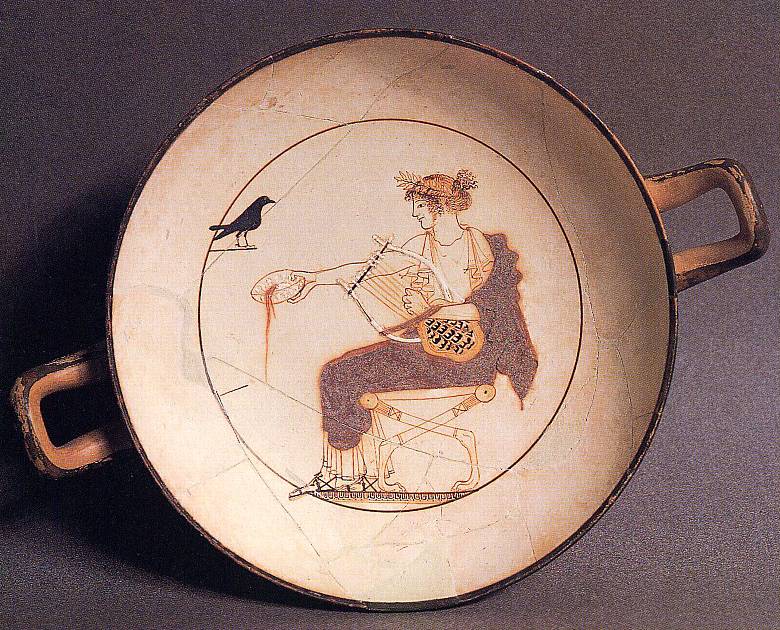
White Ground
The second image is a typical Roman-era statue of Apollo, easily recognized again by his lyre.

Roman
The third image is the sculpture by Michelangelo, but this is not considered one of his major works.

Michelangelo
We have already seen the first image in Section 3, a museum model of Olympia with the temple of Zeus in the center. Inside this temple was the colossal statue by Pheidias, but this time we are going to focus only on one of the two pediment sculptures. The fragments of these figures were discovered by archaeologists in the late 1800s, and enough remains to come up with a probable restoration, seen here.

Olympia - Model

Pediment Restoration
The story being depicted is the fight between the Lapiths and the Centaurs. The Lapiths had gathered to celebrate a marriage, but the event was disrupted when the brutish centaurs rushed in, attempting to steal the Lapith women.

Center 1
The men fought valiantly against the centaurs, and here in this pediment, we see Apollo as the tallest figure in the center, helping to subdue the centaurs. Apollo is clearly a symbol of civilization triumphing over savagery, a representative of the younger generation of the Olympians.

Center 2
The final image is a close-up of the head of Apollo. It is unquestionably a product of the early Classical period, dated to about 470 B.C. There is no explanation as to why Apollo is the major figure on a temple dedicated to Zeus.

Head
Nothing definite is known about the artist or location of this statue of the god. It is first mentioned in an inventory taken in 1509 of artwork belonging to the Vatican, where it is still on display. When scholars began the systematic study of ancient art in the 1700s, this figure was first praised as an example of the finest work of the Classical period. However, the latest opinions have reclassified this as most likely a Roman copy (perhaps 2nd Century A.D.) which was based on a 4th Century B.C. Greek work. The name Belvedere comes from the gallery in the Vatican where it is displayed.

Belvedere 1

Belvedere 2
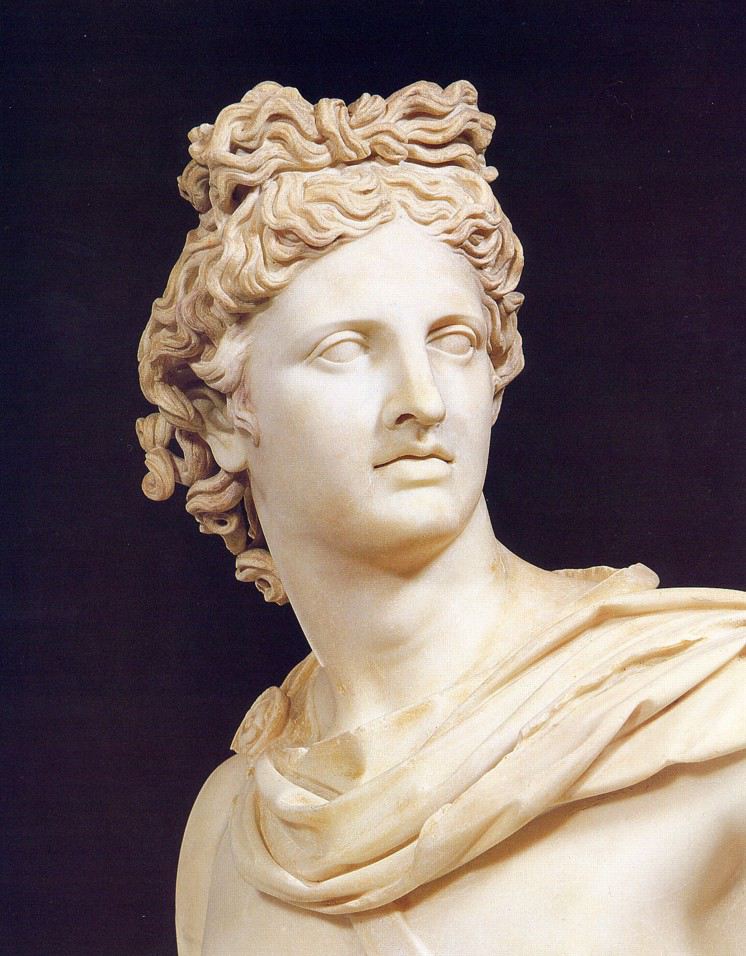
Belvedere 3
In the 1960s, the name Apollo was given to NASA's manned lunar landing program, although no one knows for sure why this god's name was chosen, since he is not closely connected with the moon. The sixth and final moon landing was the Apollo 17 mission in December 1972, and the mission patch, seen here, included the head of the Apollo Belvedere.

NASA Mission Patch
Apollo is featured in two very similar stories, in which his musical skill with the lyre is challenged by a rival. In the first story, the challenger was the god Pan, known for his talent with the syrinx, or pan-pipes. The judge of the contest was the god of Mt. Tmolus, and one spectator was king Midas.
In the first painting below by Jacob Jordaens, we see Mt. Tmolus giving Apollo the victory crown, but Midas objected, proclaiming that Pan should have won. Apollo then punished Midas by giving him the ears of an ass.

Apollo as Victor over Pan, Jordaens (c. 1636)
The second painting, by Sebastiano Ricci, clearly shows Apollo with the rays of the sun-god around him.

Apollo and Pan, Ricci (c. 1686)
The third painting, by

Apollo and Midas, Halle
In the second story it was Marsyas the satyr with his flute (introduced in the Athena article) who was Apollo's rival. The story has a very brutal ending: it was agreed that whoever won the contest could do anything he wanted to the loser, and after winning, Apollo reveals his violent side by having Marsyas skinned alive.
The image below is the Renaissance painting by Pietro Perugino, where Marsyas looks very little like a satyr, but at least Apollo can be recognized by his lyre on the ground.

Perugino
The rest of the paintings show the gory end of the story. First, the version by Raphael, then by Domenichino (Domenico Zampieri). Spanish artist Diego Ribera did the third version, and the last is the work of Titian.

Apollo and Marsyas, Raphael (1510)

Domenichino

Apollo and Marsyas, Ribera (1637)

The Flaying of Marsyas, Titian (c. 1570)
One of the most sacred places of ancient Greece was Delphi, in the region of known as Phocis. This was a fairly remote location, far from major urban centers, nestled alongside Mt. Parnassus (mentioned previously in connection with the Muses). In some ways, Delphi was similar to Olympia, in the sense that it was a sort of neutral ground, where the different cities of Greece, often in conflict with one another, could participate equally. The main attraction of Delphi was the temple of Apollo which was the site of the oracle. The remains of the temple are seen in these modern photos.

Delphi - now 1

Delphi - now 2

Delphi - now 3
Next we have a museum model of Delphi restored to its appearance in ancient times, followed by a stone which is shaped like the famous Omphalos at Delphi, said to mark the exact center of the world (the word omphalos is Greek for navel or belly-button).

Model

Omphalos
One of the most important myths about Apollo is how he became the god at Delphi, a story told in the Homeric Hymn to Apollo. This poem tells how Apollo had to first defeat a monstrous creature, the previous owner of the sacred site, known as Pytho or Python, the offsping of Typhoeus.
This is the subject of the ceiling mural in the Apollo Gallery of the Louvre by Delacroix, seen below in the first image. Apollo as the god of sunlight and order against the chaotic forces below.

Delacroix
Next is the sculpture by Auguste Rodin, showing Apollo triumphant over the dead body of Pytho.
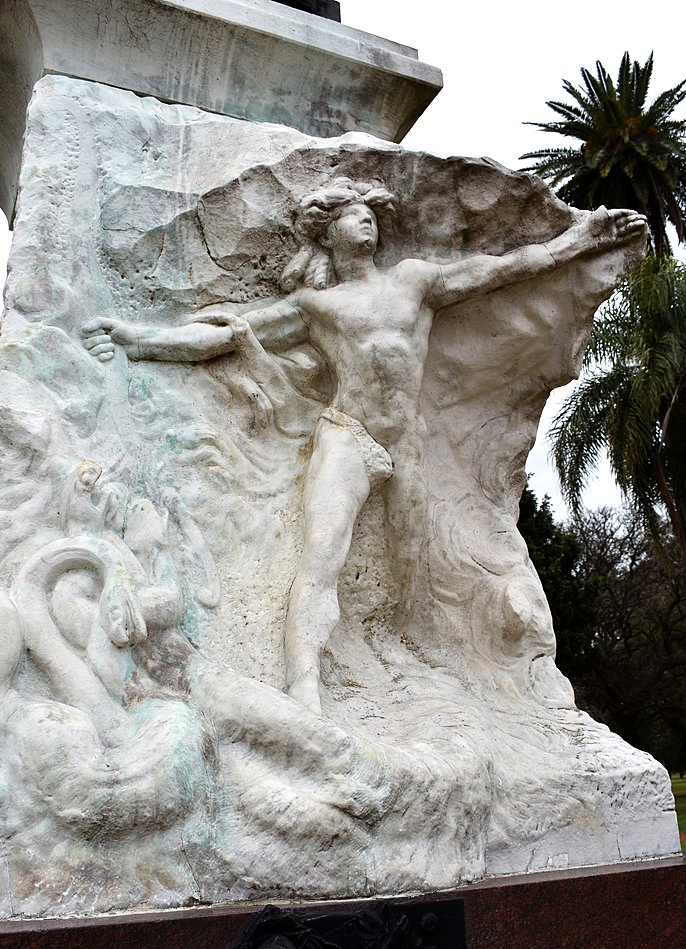
Apollo Crushing the Serpent Python, Rodin (1900)
The following red-figure vase painting depicts Apollo's priestess (known as the Pythia, a name derived from the dead monster Pytho) performing the duty of the oracle. The male on the right has come to consult the oracle, while she responds seated in a bronze tripod (an object not normally used as a chair).

Pythia
Then a painting by John Collier showing the priestess seen seated over a gaseous fissure.

Priestess of Delphi, Collier (1891)
The last two images are two views of the same red-figure vase painting, depicting Apollo himself seated in the tripod, playing his lyre. The first view clearly seems to show the tripod as a seafaring vehicle. Whether or not the oracle really had prophetic powers is of course impossible to say, but certainly the ancient Greeks firmly believed in these messages from Apollo delivered through the Pythia.

Red Figure 1

Red Figure 2
In several of the myths of Apollo, there is a recurring theme of tragic love affairs. It seems that despite his good looks, Apollo almost always got involved in relationships that didn't work out. One of the best examples is the story of Daphne.
The story begins with a quarrel between Apollo and Eros (Cupid), with Apollo claiming to be the master of archery, and Eros just a child with his tiny weapon. Eros took his revenge against Apollo by causing him to fall in love with the girl named Daphne, but he shot her with an arrow that makes her despise Apollo.
This is the scene in the first painting below by Poussin. The rest all depict the tragic end, where Daphne prays to the gods to do anything to let her escape Apollo, and the result is her transformation into the laurel tree (the word Daphne is Greek for the laurel tree).

Poussin 1
The next image is a Roman mosaic.
< class="zpic">
Mosaic
And a Renaissance painting by Pollaiuolo.

Apollo and Daphne, Pollaiuolo (c. 1470)
In the next painting, by Tiepolo, Apollo is clearly shown with the rays of the sun-god around his head.

Apollo Pursuing Daphne, Tiepolo (c. 1755)
A second painting by Poussin shows Apollo taking some of the laurel leaves to make himself a memento of his lost love.

Apollo and Daphne, Poussin (1625)
The final set of images are several different views of the Baroque sculpture by Bernini, definitely one of his finest masterpieces, now at the Borghese Gallery in Rome. It was produced between 1622-25.

Bernini

Bernini

Bernini
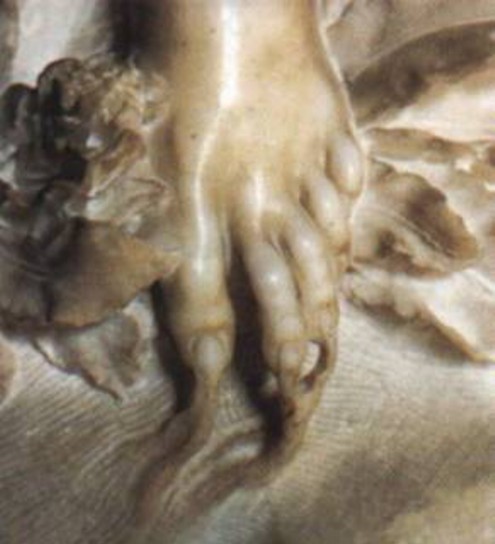
Bernini

Book

Daphne
Probably the most familiar image of this god is the way he appears here in the famous bronze sculpture from the Renaissance by Giovanni da Bologna (known sometimes as Giambologna, an abbreviation of his name). Hermes/Mercury appears as a youthful, beardless male, with his winged helmet and winged feet, symbols of his quickness. The sculpture is seen here from three slightly different angles.

Giambologna 1
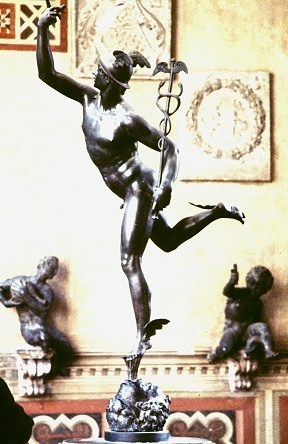
Giambologna 2

Giambologna 3
Following is a similar depiction which was part of a ceiling mural by Tiepolo. Hermes' staff, known as the caduceus, was originally the symbol of being a herald or messenger. Only later did it become associated with medicine and doctors.

Hermes, Tiepolo (1740)
The more ancient images of Hermes appear quite different, however. Originally he was a god of roads and travellers, and associated with shepherds and flocks. The first image below shows Hermes in his role of shepherd in this archaic relief sculpture.
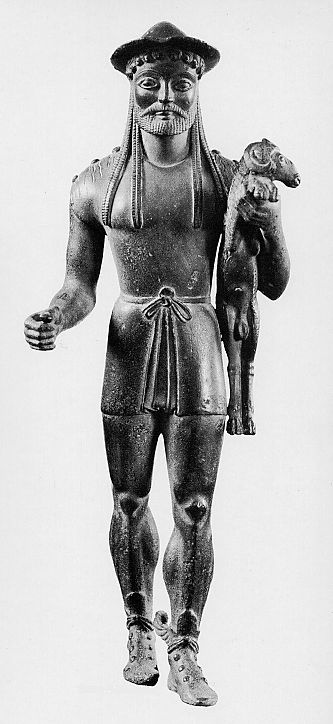
Bronze

Shepherd
Next are two examples of the objects known as a herm, a stone pillar with just the head and genitals of the god. This was a form of the god as a protector of travellers. His erection did not really pertain to sexuality. In this case, it was a symbol of power or strength to keep away the forces that might cause harm to a traveller.

Herm
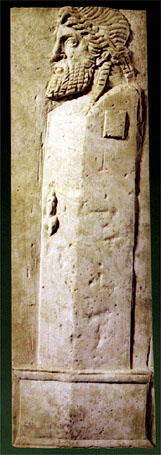
Herm
Next is a red-figure vase painting showing the scene of Hermes killing Argus, the creature with 100 eyes, who had been assigned by Zeus' jealous wife Hera to keep Io imprisoned (she was one of Zeus' many lovers, who had been transformed into a cow by Zeus in an effort to conceal her from Hera). After this deed, Hermes was given the honorary name of Argeiphontes (the killer of Argus).

Argus
Another title of the god was Psychopompus, which translates into English as "the soul guide." Part of Hermes' duties is to escort the spirits of the recently-deceased to the Underworld, and this is what we see him doing here in this white-ground vase painting (a double image shows both sides of the vase in one photo.) Hermes waits on the left as the woman who has just died prepares to follow him to the afterlife.

Psychopompus
One of he most significant sculptures of Hermes is this one, discovered in the 1800s in the ruins of Hera's temple at Olympia. Thanks to a written description recorded in ancient times, we can identify this as the work of Praxiteles, the artist most famous for the Aphrodite of Knidos, described in Section 4.
The god Hermes is seen holding the infant Dionysus, who will grow up to be the god of wine (and covered in the Adonis article). We know that the broken arm of Hermes was holding a cluster of grapes in front of the baby, teasing him with the grapes from which his wine will be made.
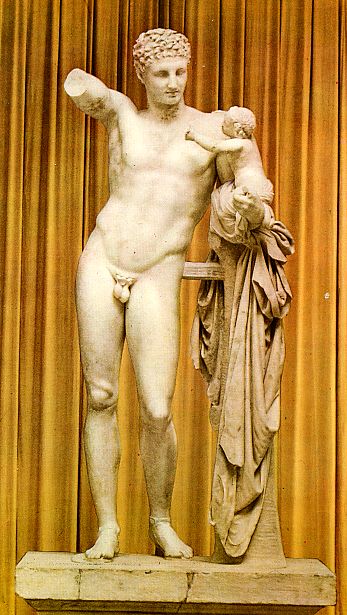
Front 1

Front 2
There is something of a controversy surrounding this sculpture, a debate on whether this is the original work of Praxiteles, or a very close copy made later. Certain details of the figure resemble trends from later times, but no one can really say for certain. If it is not the original work, it is an extremely faithful duplicate.

Head
The last view is a recent tourist photo that shows the rear view, not often pictured.

Rear
This next set of images depict the god Pan, one of the important minor gods, who is unique in that he is part human and part goat. He was a god of woodlands and pastures, known especially for two things: his extremely lustful nature and his musical instrument, the syrinx or pan-pipes.
The first images are two views (overall and a close-up) of a red-figure vase painting showing the lustful Pan pursuing a shepherd boy. This painting gives a name to the artist now known as the Pan Painter, since we do not know his actual name, as is often the case. This vase features on its opposite side the scene of Artemis and Actaeon seen in Section 5. The close-up shows the head of Pan and a somewhat comical-looking herm-statue, described just above. Certainly there is an obvious parallel being made between the herm statue and the aroused Pan.

Pan Painter

Detail
The next image is a Hellenistic sculpture of Pan with a young man, a mythical musician named Olympus. Although it seems innocent at first, with Pan teaching him to play the pipes, there is little doubt that Pan has more on his mind than a music lesson.

Olympus
After that is a sculpture we saw previously in Section 4, with Pan putting the moves on Aphrodite, a Hellenistic work found on the island of Delos.

Delos
One more depiction of Pan from the ancient world is this wall painting from Pompeii.

Pompeii
Next is part of a huge painting by Giulio Romano which depicted the wedding of Cupid and Psyche (a story mentioned in Section 4). We see here just the portion with Pan on the far right. Notice his rather demonic or satanic appearance. It is thought that the traditional imagery of Satan as being goat-like in appearance probably derives from the god Pan.

Romano
The Swiss artist Arnold Böcklin produced several painting of Pan in the 1800s. Here are two of them, Pan among the reeds and Pan between the pillars.

Böcklin

Böcklin
The last painting is by Jordaens, which illustrates the story of Pan and Syrinx. Very much like the story of Apollo and Daphne, Pan was attracted to her, but she wanted nothing to do with him and prayed for some escape. She was then transformed into a reed plant. Pan tore out these reeds searching for her. After he gave up, he picked up some of those reeds, bound them together, and thus created his instrument, still known today as the pan pipes.

Jordaens